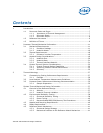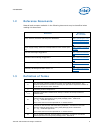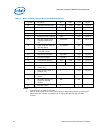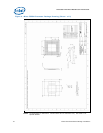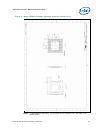
Processor Thermal/Mechanical Information
Thermal and Mechanical Design Guidelines 11
2 Processor Thermal/Mechanical
Information
2.1 Mechanical Requirements
2.1.1 Processor Package
The Intel Celeron processor 200 sequence is available in a 479-pin Micro-FCBGA
package, as shown in
Figure 1 to Figure 3. The processor uses a Flip-Chip Ball Grid
Array (FC-BGA6) package technology that directly solder down to a 479-pin footprint
on PCB surface.
Mechanical specifications of the package are listed in
Table 1. Refer to the datasheet
for detailed mechanical specifications. In case of conflict, the package dimensions in
the datasheet supersedes dimensions provided in this document.
The processor package has mechanical load limits that are specified in the processor
datasheet. The specified maximum static and dynamic load limits should not be
exceeded during their respective stress conditions. These include heatsink
installation, removal, mechanical stress testing, and standard shipping conditions.
• When a compressive static load is necessary to ensure thermal performance of the
thermal interface material between the heatsink base and the processor die, it
should not exceed the corresponding specification given in the processor
datasheet.
• When a compressive static load is necessary to ensure mechanical performance, it
should remain in the minimum/maximum range specified in the processor
datasheet.
No portion of the substrate should be used as a mechanical reference or load-bearing
surface for the thermal or mechanical solution.
The processor datasheet provides package handling guidelines in terms of maximum
recommended shear, tensile and torque loads for the processor substrate. These
recommendations should be followed in particular for heatsink removal operations.



